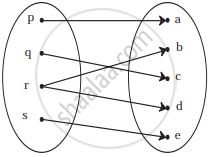Advertisements
Advertisements
प्रश्न
f, g, h are three function defined from R to R as follow:
(ii) g(x) = sin x
Find the range of function.
उत्तर
(ii) Given:
g(x) = sin x
Range of g(x) = {y ∈ R : - 1 ≤ y ≤ 1}
APPEARS IN
संबंधित प्रश्न
Let X = {1, 2, 3, 4} and Y = {1, 5, 9, 11, 15, 16}
Determine which of the set are functions from X to Y.
(c) f3 = {(1, 5), (2, 9), (3, 1), (4, 5), (2, 11)}
If f : R → R be defined by f(x) = x2 + 1, then find f−1 [17] and f−1 [−3].
If \[f\left( x \right) = \frac{2x}{1 + x^2}\] , show that f(tan θ) = sin 2θ.
Let f and g be two real functions defined by \[f\left( x \right) = \sqrt{x + 1}\] and \[g\left( x \right) = \sqrt{9 - x^2}\] . Then, describe function:
(i) f + g
Let f and g be two real functions defined by \[f\left( x \right) = \sqrt{x + 1}\] and \[g\left( x \right) = \sqrt{9 - x^2}\] . Then, describe function:
(vi) \[2f - \sqrt{5} g\]
If f(x) = loge (1 − x) and g(x) = [x], then determine function:
(iv) \[\frac{g}{f}\] Also, find (f + g) (−1), (fg) (0),
Let f and g be two real functions given by
f = {(0, 1), (2, 0), (3, −4), (4, 2), (5, 1)} and g = {(1, 0), (2, 2), (3, −1), (4, 4), (5, 3)}
Find the domain of fg.
If A = {1, 2, 3} and B = {x, y}, then the number of functions that can be defined from A into B is
If f(x) = cos (log x), then value of \[f\left( x \right) f\left( 4 \right) - \frac{1}{2} \left\{ f\left( \frac{x}{4} \right) + f\left( 4x \right) \right\}\] is
The domain of the function
Check if the following relation is function:

Check if the following relation is function:

Check if the relation given by the equation represents y as function of x:
3x − 6 = 21
Find x, if g(x) = 0 where g(x) = 6x2 + x − 2
Find the domain and range of the following function.
f(x) = `sqrt((x - 2)(5 - x)`
Express the area A of a square as a function of its side s
Show that if f : A → B and g : B → C are one-one, then g ° f is also one-one
Express the following exponential equation in logarithmic form
10−2 = 0.01
Express the following exponential equation in logarithmic form
`"e"^(1/2)` = 1.6487
Express the following logarithmic equation in exponential form
log2 64 = 6
Write the following expression as sum or difference of logarithm
`log (sqrt(x) root(3)(y))`
Solve for x.
log2 + log(x + 3) – log(3x – 5) = log3
Solve for x.
log2 x + log4 x + log16 x = `21/4`
Answer the following:
Identify the following relation is the function? If it is a function determine its domain and range.
{(2, 1), (4, 2), (6, 3), (8, 4), (10, 5), (12, 6), (14, 7)}
Answer the following:
Find whether the following function is one-one
f : R → R defined by f(x) = x2 + 5
Answer the following:
If f(x) = 3x + a and f(1) = 7 find a and f(4)
Answer the following:
Find x, if x = 33log32
Answer the following:
If b2 = ac. prove that, log a + log c = 2 log b
Answer the following:
If a2 = b3 = c4 = d5, show that loga bcd = `47/30`
Find the domain of the following function.
f(x) = `sqrtlog(x^2 - 6x + 6)`
Let f = {(x, y) | x, y ∈ N and y = 2x} be a relation on N. Find the domain, co-domain and range. Is this relation a function?
The range of 7, 11, 16, 27, 31, 33, 42, 49 is ______.
Find the domain of the following functions given by f(x) = x|x|
Find the domain of the following functions given by f(x) = `(x^3 - x + 3)/(x^2 - 1)`
If f(x) = `(x - 1)/(x + 1)`, then show that `f(- 1/x) = (-1)/(f(x))`
The domain of the function f given by f(x) = `(x^2 + 2x + 1)/(x^2 - x - 6)` is ______.
The domain of the function f(x) = `1/sqrt(|x| - x)` is ______.
If f: R `rightarrow` R be a function defined by f(x) = 4x3 – 7. Then ______.
